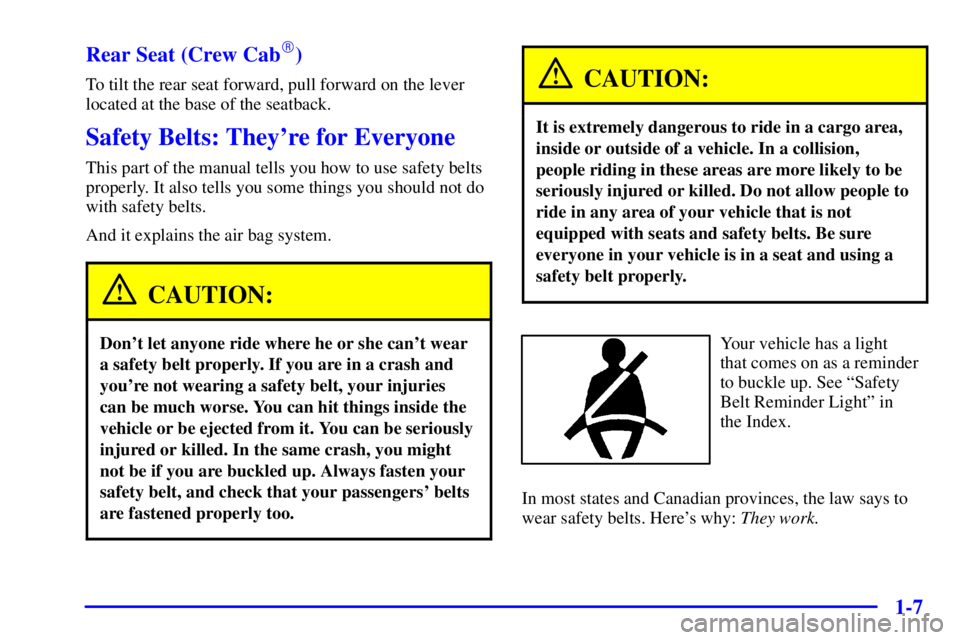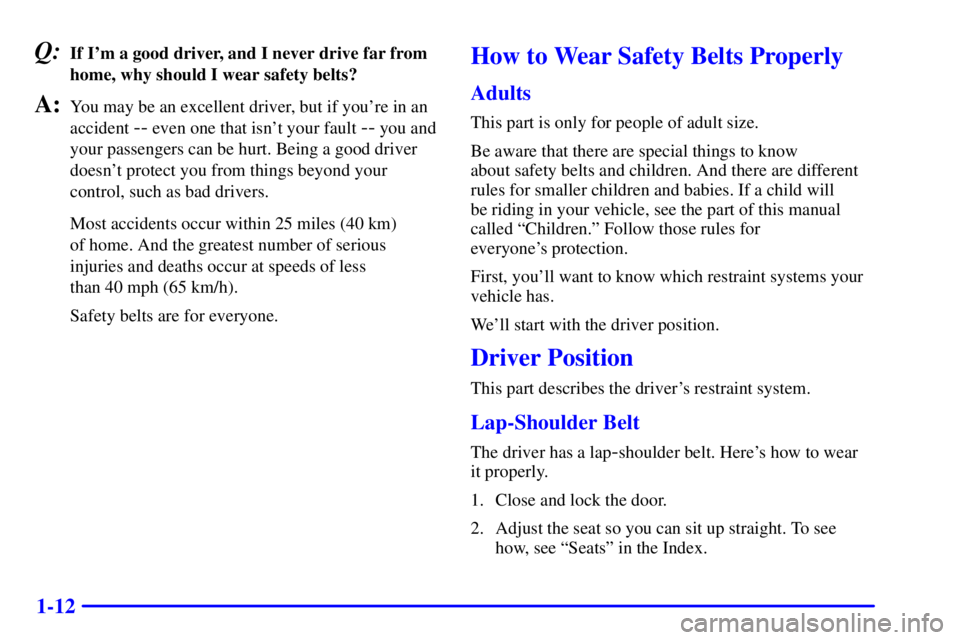Page 4 of 407
Table of Contents
Windows
Keys and Door Locks
Remote Keyless Entry (If Equipped)
Tailgate
Automatic Transmission (If Equipped)
Manual Transmission Operation (If Equipped)
Four-Wheel Drive (If Equipped)
Parking Brake
Tilt Wheel (If Equipped)Turn Signal/Multifunction Lever
Windshield Wipers
Cruise Control (If Equipped)
Exterior and Interior Lamps
Mirrors
Storage Compartments
Accessory Power Outlets
OnStar
® System (If Equipped)
Instrument Panel, Warning Lights and Gages Seats and Seat Controls
Safety BeltsAir Bag Systems
Restraint Systems for Children
Section
1
Section
2
Seats and Restraint Systems
Features and Controls
ii
Page 14 of 407
1-
1-1
Section 1 Seats and Restraint Systems
Here you'll find information about the seats in your vehicle and how to use your safety belts properly. You can also
learn about some things you should not do with air bags and safety belts.
1
-2 Seats and Seat Controls
1
-7 Safety Belts: They're for Everyone
1
-11 Here Are Questions Many People Ask About
Safety Belts
-- and the Answers
1
-12 How to Wear Safety Belts Properly
1
-12 Driver Position
1
-19 Safety Belt Use During Pregnancy
1
-20 Right Front Passenger Position
1
-20 Air Bag System
1
-30 Center Passenger Position1
-32 Rear Seat Passengers (Extended Cab
Jump Seats)
1
-33 Rear Seat Passengers
1
-37 Children
1
-41 Restraint Systems for Children
1
-55 Older Children
1
-58 Safety Belt Extender
1
-58 Checking Your Restraint Systems
1
-58 Replacing Restraint System Parts After
a Crash
Page 15 of 407
1-2
Seats and Seat Controls
This section tells you about the seats -- how to adjust
them, and fold them up and down.
Manual Front Seat
CAUTION:
You can lose control of the vehicle if you try to
adjust a manual driver's seat while the vehicle is
moving. The sudden movement could startle and
confuse you, or make you push a pedal when you
don't want to. Adjust the driver's seat only when
the vehicle is not moving.
Move the lever under the front of the manual seat up to
unlock it. Slide the seat to where you want it. Then
release the lever and try to move the seat with your body
to make sure the seat is locked into place.
Page 16 of 407
1-3 Manual Lumbar Support (If Equipped)
If you have this feature,
there will be a knob on the
outside of the driver's
bucket seat.
Turn the knob toward the front of the vehicle to increase
lumbar support and toward the rear of the vehicle to
decrease lumbar support.
Reclining Seatbacks (Bucket Seats or
60/40 Bench)
To adjust the front seatback,
lift the lever on the outside
of the seat.
Release the lever to lock the seatback where you
want it. Pull up on the lever and the seat will go to an
upright position.
Page 20 of 407

1-7 Rear Seat (Crew Cab
�)
To tilt the rear seat forward, pull forward on the lever
located at the base of the seatback.
Safety Belts: They're for Everyone
This part of the manual tells you how to use safety belts
properly. It also tells you some things you should not do
with safety belts.
And it explains the air bag system.
CAUTION:
Don't let anyone ride where he or she can't wear
a safety belt properly. If you are in a crash and
you're not wearing a safety belt, your injuries
can be much worse. You can hit things inside the
vehicle or be ejected from it. You can be seriously
injured or killed. In the same crash, you might
not be if you are buckled up. Always fasten your
safety belt, and check that your passengers' belts
are fastened properly too.
CAUTION:
It is extremely dangerous to ride in a cargo area,
inside or outside of a vehicle. In a collision,
people riding in these areas are more likely to be
seriously injured or killed. Do not allow people to
ride in any area of your vehicle that is not
equipped with seats and safety belts. Be sure
everyone in your vehicle is in a seat and using a
safety belt properly.
Your vehicle has a light
that comes on as a reminder
to buckle up. See ªSafety
Belt Reminder Lightº in
the Index.
In most states and Canadian provinces, the law says to
wear safety belts. Here's why: They work.
Page 25 of 407

1-12
Q:If I'm a good driver, and I never drive far from
home, why should I wear safety belts?
A:You may be an excellent driver, but if you're in an
accident
-- even one that isn't your fault -- you and
your passengers can be hurt. Being a good driver
doesn't protect you from things beyond your
control, such as bad drivers.
Most accidents occur within 25 miles (40 km)
of home. And the greatest number of serious
injuries and deaths occur at speeds of less
than 40 mph (65 km/h).
Safety belts are for everyone.
How to Wear Safety Belts Properly
Adults
This part is only for people of adult size.
Be aware that there are special things to know
about safety belts and children. And there are different
rules for smaller children and babies. If a child will
be riding in your vehicle, see the part of this manual
called ªChildren.º Follow those rules for
everyone's protection.
First, you'll want to know which restraint systems your
vehicle has.
We'll start with the driver position.
Driver Position
This part describes the driver's restraint system.
Lap-Shoulder Belt
The driver has a lap-shoulder belt. Here's how to wear
it properly.
1. Close and lock the door.
2. Adjust the seat so you can sit up straight. To see
how, see ªSeatsº in the Index.
Page 45 of 407
1-32
Rear Seat Passengers
(Extended Cab Jump Seats)
Lap Belt
These are reserve seating positions equipped with lap
belts only. (If your extended cab pickup has the
optional side access panel, there's only one reserve
seating position.)
It's very important for rear seat passengers to buckle up!
Accident statistics show that unbelted people in the rear
seat are hurt more often in crashes than those who are
wearing safety belts.Rear passengers who aren't safety belted can be thrown
out of the vehicle in a crash. And they can strike others
in the vehicle who are wearing safety belts.
Each jump seat has a lap belt with no retractor.
To make the belt longer, tilt the latch plate and pull
it along the belt.
Page 46 of 407
1-33
To make it shorter, pull the belt as shown until it is snug.
Buckle and position it the same way as the lap part of
the driver's safety belt. See ªDriver Positionº in the
Index. Make sure the release button on the buckle is
positioned so you would be able to unbuckle the safety
belt quickly if you ever had to. To unlatch the belt, just
push the button on the buckle.
Don't use child restraints on these seats. They won't
work properly.
Rear Seat Passengers
It's very important for rear seat passengers to buckle up!
Accident statistics show that unbelted people in the rear
seat are hurt more often in crashes than those who are
wearing safety belts.
Rear passengers who aren't safety belted can be thrown
out of the vehicle in a crash. And they can strike others
in the vehicle who are wearing safety belts.
Rear Seat Outside Passenger Positions
(Crew Cab)